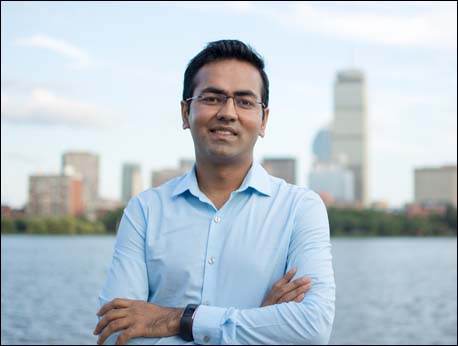
Bangalore September14, 2016 – When he came to Stanford to pursue his MS and PhD a few years ago, Dinesh Bharadia, an Electrical Engineering graduate of IIT Kanpur, wanted to solve “an interesting, hard problem.” He chose one that had stumped scientists for almost 150 years.
Now, the 28-year-old Stanford PhD, currently a researcher at MIT, has been honored for the resulting work with the 2016 Marconi Society Paul Baran Young Scholar Award.
Bharadia will receive the award at a ceremony at the Computer History Museum in Mountain View, California, on November 2.
Bharadia’s research disproved a long-held assumption that it is “generally not possible for a radio to receive and transmit on the same frequency band because of the interference that results.” His work culminated in making full-duplex radios a reality through the development of effective self-interference cancellation technology.
“Let’s say you are shouting at someone and they are shouting at you,” Bharadia explains. “Neither of you can hear the other, because you are both shouting in the same frequency. The noise in your ears (“interference”) from your own shout prevents you from hearing the other person. That’s a good analogy for why radios have needed to use two different frequencies to transmit and receive simultaneously. It’s also why solving the challenge of developing ‘full duplex radios’ effectively doubles the amount of available spectrum.”
The problem is more difficult than it sounds, says Bharadia. First, the interference is extremely strong—nearly a hundred billion times stronger than the signal that the radio might be trying to receive—and the resulting interference depends on the environment and its reflectors, changing in real-time as people move around. Plus, typical radios (e.g., Wi-Fi) span many frequencies and use multi-antenna systems. Nonetheless, Bharadia was able to demonstrate systems that overcame all these obstacles. He turned full-duplex radios into a commercial reality by inventing new formulas that could in real-time, model the non-linear, time-varying self-interference as well as analog and digital self-interference cancellation circuits to apply the model to the known transmitted signal and cancel the self-interference
The analog cancellation filter Bharadia developed, also unleashed the potential for many more applications. The unique architecture had to allow cancellation in all environments. According to Bharadia’s PhD advisor at Stanford, Prof. Sachin Katti, “Dinesh’s work enables a whole host of new applications, from extremely low-power Internet of Things connectivity to motion tracking. It has the potential to be used for important future applications such as building novel wireless imaging that can enable driverless cars in severe weather scenarios, help blind people to navigate indoors, and much more.” Bharadia took a leave of absence from his doctorate studies at Stanford so he could commercialize the radio through the startup Kumu Networks founded by his guide Prof Katti tro commercialize full duplex radio.
Bharadia thinks receiving the Marconi Young Scholar award is especially rewarding because his work has a direct connection to Marconi. “Marconi, invented the radio but couldn’t solve the problem of duplexing,” he says. “It’s fitting that this work should be recognized by the Marconi Society.”
Asked how he thought his work could help leverage communications in a developing scenario like India, Bharadia says: "India has much denser users when it comes to cellular data connectivity and very few cellular towers. Firstly, if one can talk and listen at the same time in the context of wireless radio, one can double the data we can service. Second, this technology can be used to build cheap-efficient full-duplex relays i.e. relays which can listen to signal from the cellular tower and at the same transmit it instantaneously, which would help us to extend the range very easily. We have fewer cellular towers in India; by deploying these cheap-efficient full-duplex relays, we don't need to deploy expensive cellular tower infrastructure, but gain similar benefits.”
Young Scholar candidates are nominated by their academic advisors. Winners are selected by an international panel comprised of engineers from leading universities and companies, and receive a $4000 prize plus expenses to attend the annual awards event. Three other Young Scholars were selected this year.